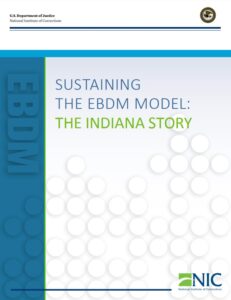 Evidence-Based Decision Making (EBDM) is an approach to developing criminal justice policies and processes at the state and local levels. It uses data and empirical research as catalysts for change. Those who have used it describe it as an “opportunity to evaluate justice programs objectively with data, and use data to make improvements.”
Evidence-Based Decision Making (EBDM) is an approach to developing criminal justice policies and processes at the state and local levels. It uses data and empirical research as catalysts for change. Those who have used it describe it as an “opportunity to evaluate justice programs objectively with data, and use data to make improvements.”
In a new report titled Sustaining the EBDM Model: The Indiana Story, the National Institute of Corrections (NIC) reveals how, as part of a multi-phase pilot study, Grant County, Indiana, realized numerous breakthroughs in community supervision, data collection, and pretrial services by applying EBDM. Steering the county was a policy team comprising local stakeholders who worked closely with NIC to develop a set of realistic, attainable goals. They included:
- Restructuring caseloads to optimize supervision for people at the highest risk to reoffend
- Revising the probation violations process to expand alternatives to revocation
- Enhancing data collection
Based on those goals, Grant County was able to attain the following wins:
- 42% decrease in people on probation being convicted of a misdemeanor
- 26% reduction in people on probation being convicted of a felony
- 19% reduction in new referrals to supervision, leaving more time to implement behavioral interventions with people at the highest risk to reoffend
According to Mark Spitzer, Grant County Circuit Court Judge and Chair of the Grant County, Indiana’s EBDM policy team, EBDM was “a resounding success.” Implementation has allowed the jurisdiction “to get many people on the track toward successful completion of probation or community corrections, where they might have otherwise failed in the past,” Spitzer says.
What initially began as a pilot project in Grant County subsequently expanded to multiple counties in Indiana and a state team of policymakers. Two pieces of legislation (House Enrolled Act 1006-2015 and 1068-2021) ultimately codified multi-disciplinary, strategic collaborative teams at the state-level and in all of Indiana’s 92 counties.
Indiana’s involvement with EBDM, the successes they achieved, and the efforts of the state to sustain the use of EBDM in the future are told in full detail in Sustaining the EBDM Model: The Indiana Story and is now available.
For more information about EBDM, contact Holly Busby, Chief, Community Services Division at hbusby@bop.gov.
